Marketing Strategies and Customer Value: A Report on Audi Cars
VerifiedAdded on 2021/02/22
|10
|3060
|105
Report
AI Summary
This report provides a comprehensive analysis of Audi's marketing strategies, focusing on the A1 and A3 models. It begins with an introduction to marketing and its role in creating customer relationships and satisfaction, particularly within the context of the automotive industry. The report delves into the marketing process, outlining the stages of market opportunity analysis, target market selection, and the development of the marketing mix (product, price, place, and promotion). It examines how Audi creates value for its customers and the importance of stakeholder engagement, including internal stakeholders like directors, managers, employees, and customers, as well as external stakeholders such as the government and media. The report also includes a blog post that discusses the Audi A1 and A3 models, providing an overview of Audi's marketing approaches and their impact on customer perception and brand loyalty. The report covers the key aspects of Audi's marketing efforts, from market segmentation to promotional activities, highlighting how the company maintains its premium brand image and adapts to the competitive market environment.
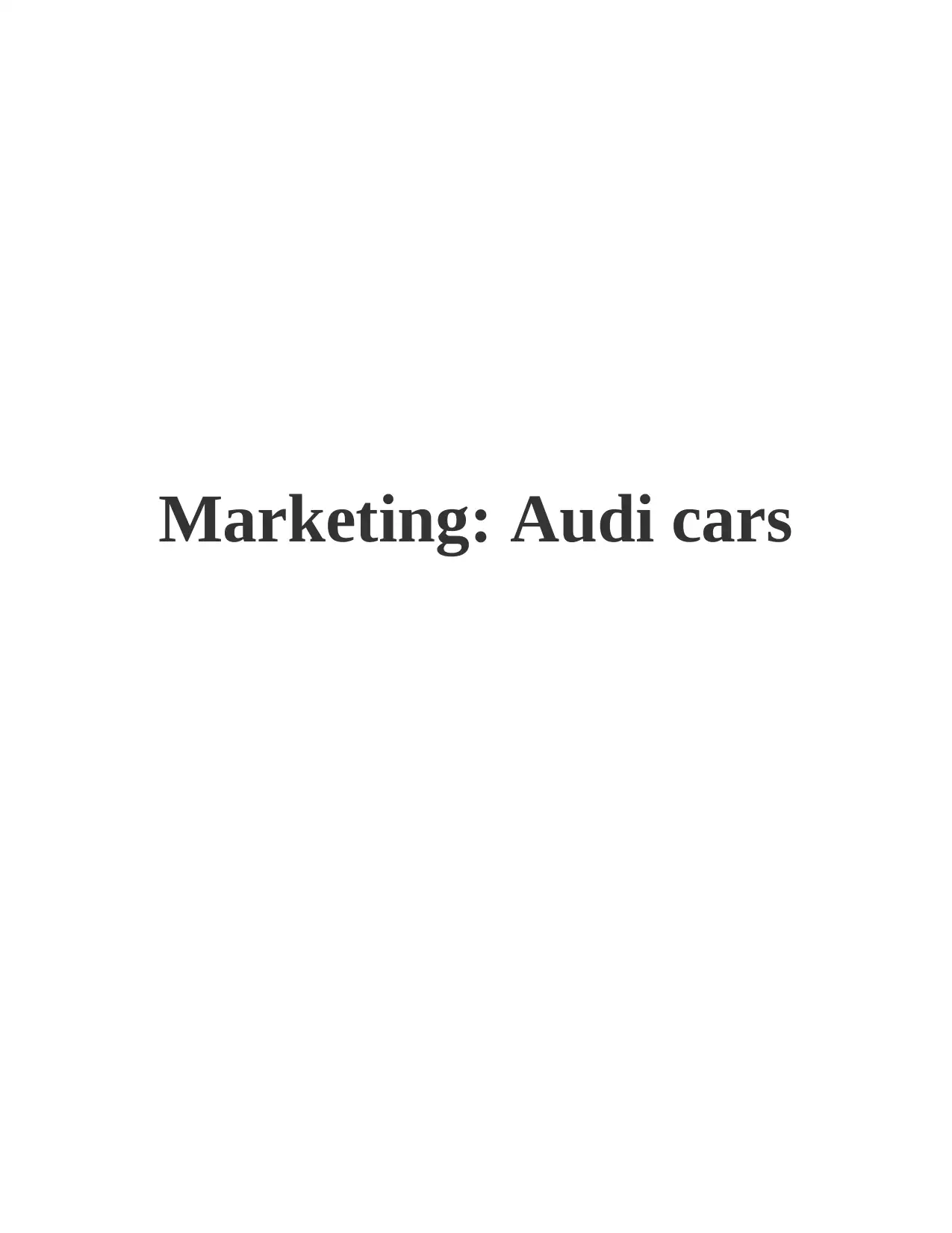
Marketing: Audi cars
Paraphrase This Document
Need a fresh take? Get an instant paraphrase of this document with our AI Paraphraser
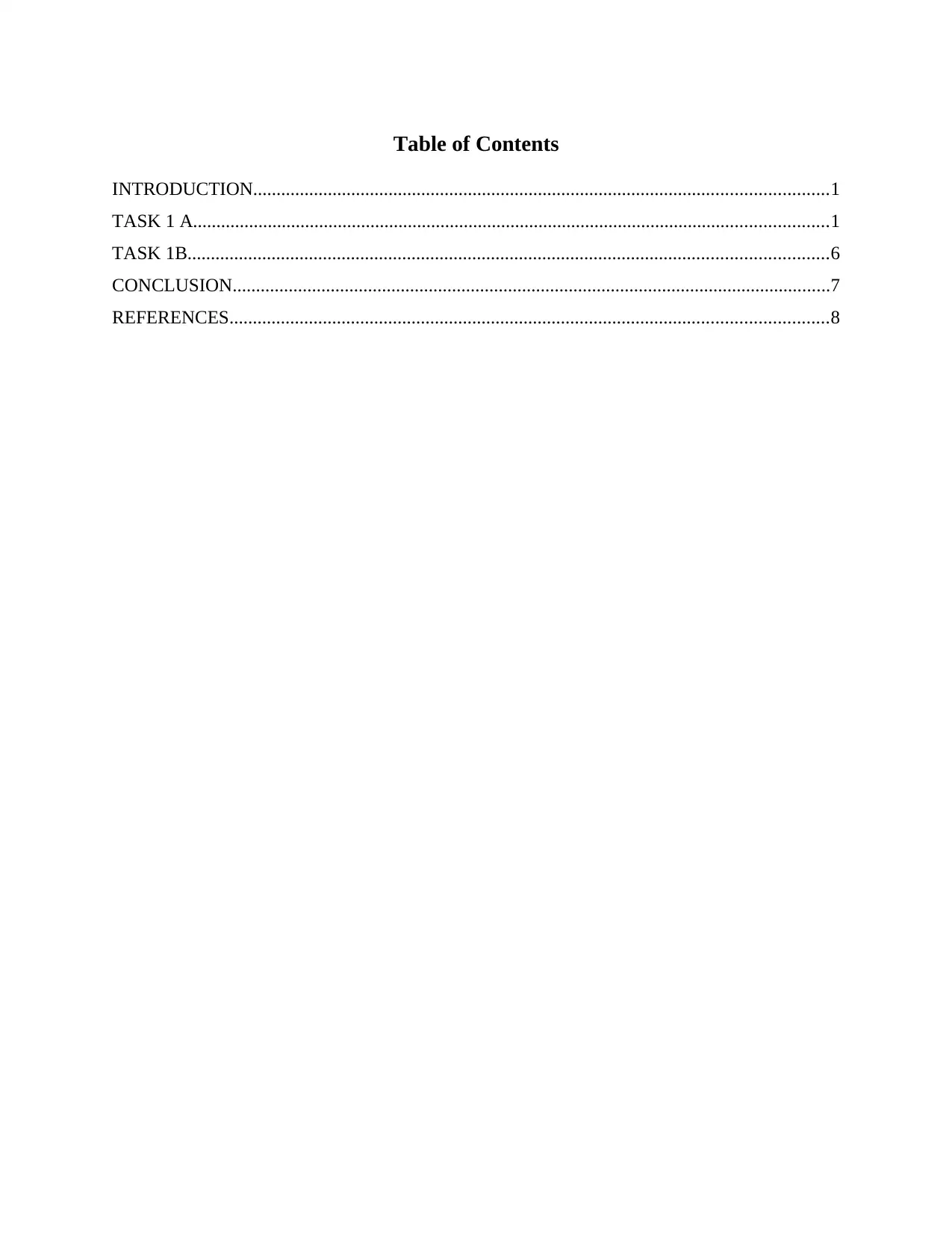
Table of Contents
INTRODUCTION...........................................................................................................................1
TASK 1 A........................................................................................................................................1
TASK 1B.........................................................................................................................................6
CONCLUSION................................................................................................................................7
REFERENCES................................................................................................................................8
INTRODUCTION...........................................................................................................................1
TASK 1 A........................................................................................................................................1
TASK 1B.........................................................................................................................................6
CONCLUSION................................................................................................................................7
REFERENCES................................................................................................................................8
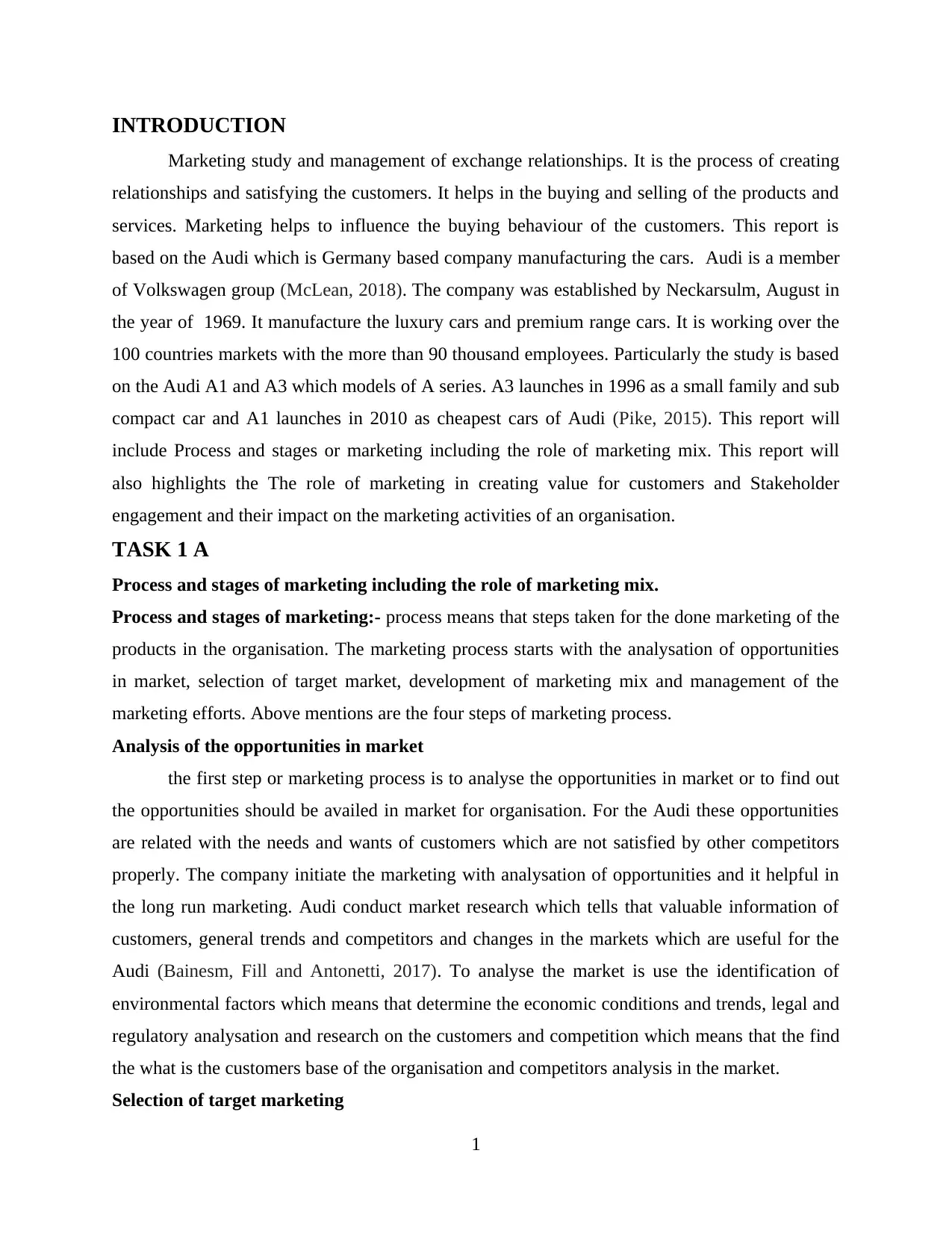
INTRODUCTION
Marketing study and management of exchange relationships. It is the process of creating
relationships and satisfying the customers. It helps in the buying and selling of the products and
services. Marketing helps to influence the buying behaviour of the customers. This report is
based on the Audi which is Germany based company manufacturing the cars. Audi is a member
of Volkswagen group (McLean, 2018). The company was established by Neckarsulm, August in
the year of 1969. It manufacture the luxury cars and premium range cars. It is working over the
100 countries markets with the more than 90 thousand employees. Particularly the study is based
on the Audi A1 and A3 which models of A series. A3 launches in 1996 as a small family and sub
compact car and A1 launches in 2010 as cheapest cars of Audi (Pike, 2015). This report will
include Process and stages or marketing including the role of marketing mix. This report will
also highlights the The role of marketing in creating value for customers and Stakeholder
engagement and their impact on the marketing activities of an organisation.
TASK 1 A
Process and stages of marketing including the role of marketing mix.
Process and stages of marketing:- process means that steps taken for the done marketing of the
products in the organisation. The marketing process starts with the analysation of opportunities
in market, selection of target market, development of marketing mix and management of the
marketing efforts. Above mentions are the four steps of marketing process.
Analysis of the opportunities in market
the first step or marketing process is to analyse the opportunities in market or to find out
the opportunities should be availed in market for organisation. For the Audi these opportunities
are related with the needs and wants of customers which are not satisfied by other competitors
properly. The company initiate the marketing with analysation of opportunities and it helpful in
the long run marketing. Audi conduct market research which tells that valuable information of
customers, general trends and competitors and changes in the markets which are useful for the
Audi (Bainesm, Fill and Antonetti, 2017). To analyse the market is use the identification of
environmental factors which means that determine the economic conditions and trends, legal and
regulatory analysation and research on the customers and competition which means that the find
the what is the customers base of the organisation and competitors analysis in the market.
Selection of target marketing
1
Marketing study and management of exchange relationships. It is the process of creating
relationships and satisfying the customers. It helps in the buying and selling of the products and
services. Marketing helps to influence the buying behaviour of the customers. This report is
based on the Audi which is Germany based company manufacturing the cars. Audi is a member
of Volkswagen group (McLean, 2018). The company was established by Neckarsulm, August in
the year of 1969. It manufacture the luxury cars and premium range cars. It is working over the
100 countries markets with the more than 90 thousand employees. Particularly the study is based
on the Audi A1 and A3 which models of A series. A3 launches in 1996 as a small family and sub
compact car and A1 launches in 2010 as cheapest cars of Audi (Pike, 2015). This report will
include Process and stages or marketing including the role of marketing mix. This report will
also highlights the The role of marketing in creating value for customers and Stakeholder
engagement and their impact on the marketing activities of an organisation.
TASK 1 A
Process and stages of marketing including the role of marketing mix.
Process and stages of marketing:- process means that steps taken for the done marketing of the
products in the organisation. The marketing process starts with the analysation of opportunities
in market, selection of target market, development of marketing mix and management of the
marketing efforts. Above mentions are the four steps of marketing process.
Analysis of the opportunities in market
the first step or marketing process is to analyse the opportunities in market or to find out
the opportunities should be availed in market for organisation. For the Audi these opportunities
are related with the needs and wants of customers which are not satisfied by other competitors
properly. The company initiate the marketing with analysation of opportunities and it helpful in
the long run marketing. Audi conduct market research which tells that valuable information of
customers, general trends and competitors and changes in the markets which are useful for the
Audi (Bainesm, Fill and Antonetti, 2017). To analyse the market is use the identification of
environmental factors which means that determine the economic conditions and trends, legal and
regulatory analysation and research on the customers and competition which means that the find
the what is the customers base of the organisation and competitors analysis in the market.
Selection of target marketing
1
⊘ This is a preview!⊘
Do you want full access?
Subscribe today to unlock all pages.

Trusted by 1+ million students worldwide
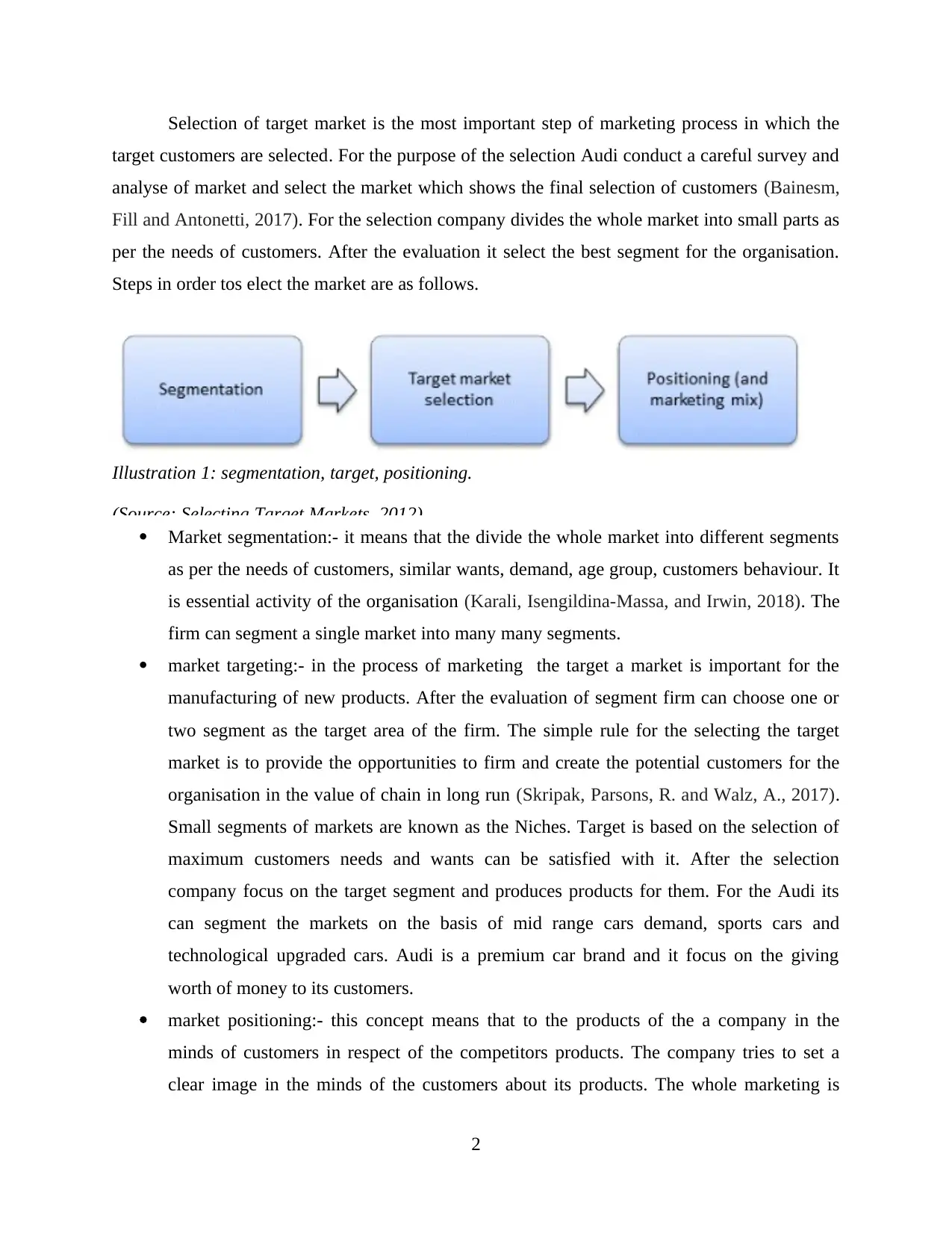
Selection of target market is the most important step of marketing process in which the
target customers are selected. For the purpose of the selection Audi conduct a careful survey and
analyse of market and select the market which shows the final selection of customers (Bainesm,
Fill and Antonetti, 2017). For the selection company divides the whole market into small parts as
per the needs of customers. After the evaluation it select the best segment for the organisation.
Steps in order tos elect the market are as follows.
Illustration 1: segmentation, target, positioning.
(Source: Selecting Target Markets, 2012)
Market segmentation:- it means that the divide the whole market into different segments
as per the needs of customers, similar wants, demand, age group, customers behaviour. It
is essential activity of the organisation (Karali, Isengildina-Massa, and Irwin, 2018). The
firm can segment a single market into many many segments.
market targeting:- in the process of marketing the target a market is important for the
manufacturing of new products. After the evaluation of segment firm can choose one or
two segment as the target area of the firm. The simple rule for the selecting the target
market is to provide the opportunities to firm and create the potential customers for the
organisation in the value of chain in long run (Skripak, Parsons, R. and Walz, A., 2017).
Small segments of markets are known as the Niches. Target is based on the selection of
maximum customers needs and wants can be satisfied with it. After the selection
company focus on the target segment and produces products for them. For the Audi its
can segment the markets on the basis of mid range cars demand, sports cars and
technological upgraded cars. Audi is a premium car brand and it focus on the giving
worth of money to its customers.
market positioning:- this concept means that to the products of the a company in the
minds of customers in respect of the competitors products. The company tries to set a
clear image in the minds of the customers about its products. The whole marketing is
2
target customers are selected. For the purpose of the selection Audi conduct a careful survey and
analyse of market and select the market which shows the final selection of customers (Bainesm,
Fill and Antonetti, 2017). For the selection company divides the whole market into small parts as
per the needs of customers. After the evaluation it select the best segment for the organisation.
Steps in order tos elect the market are as follows.
Illustration 1: segmentation, target, positioning.
(Source: Selecting Target Markets, 2012)
Market segmentation:- it means that the divide the whole market into different segments
as per the needs of customers, similar wants, demand, age group, customers behaviour. It
is essential activity of the organisation (Karali, Isengildina-Massa, and Irwin, 2018). The
firm can segment a single market into many many segments.
market targeting:- in the process of marketing the target a market is important for the
manufacturing of new products. After the evaluation of segment firm can choose one or
two segment as the target area of the firm. The simple rule for the selecting the target
market is to provide the opportunities to firm and create the potential customers for the
organisation in the value of chain in long run (Skripak, Parsons, R. and Walz, A., 2017).
Small segments of markets are known as the Niches. Target is based on the selection of
maximum customers needs and wants can be satisfied with it. After the selection
company focus on the target segment and produces products for them. For the Audi its
can segment the markets on the basis of mid range cars demand, sports cars and
technological upgraded cars. Audi is a premium car brand and it focus on the giving
worth of money to its customers.
market positioning:- this concept means that to the products of the a company in the
minds of customers in respect of the competitors products. The company tries to set a
clear image in the minds of the customers about its products. The whole marketing is
2
Paraphrase This Document
Need a fresh take? Get an instant paraphrase of this document with our AI Paraphraser
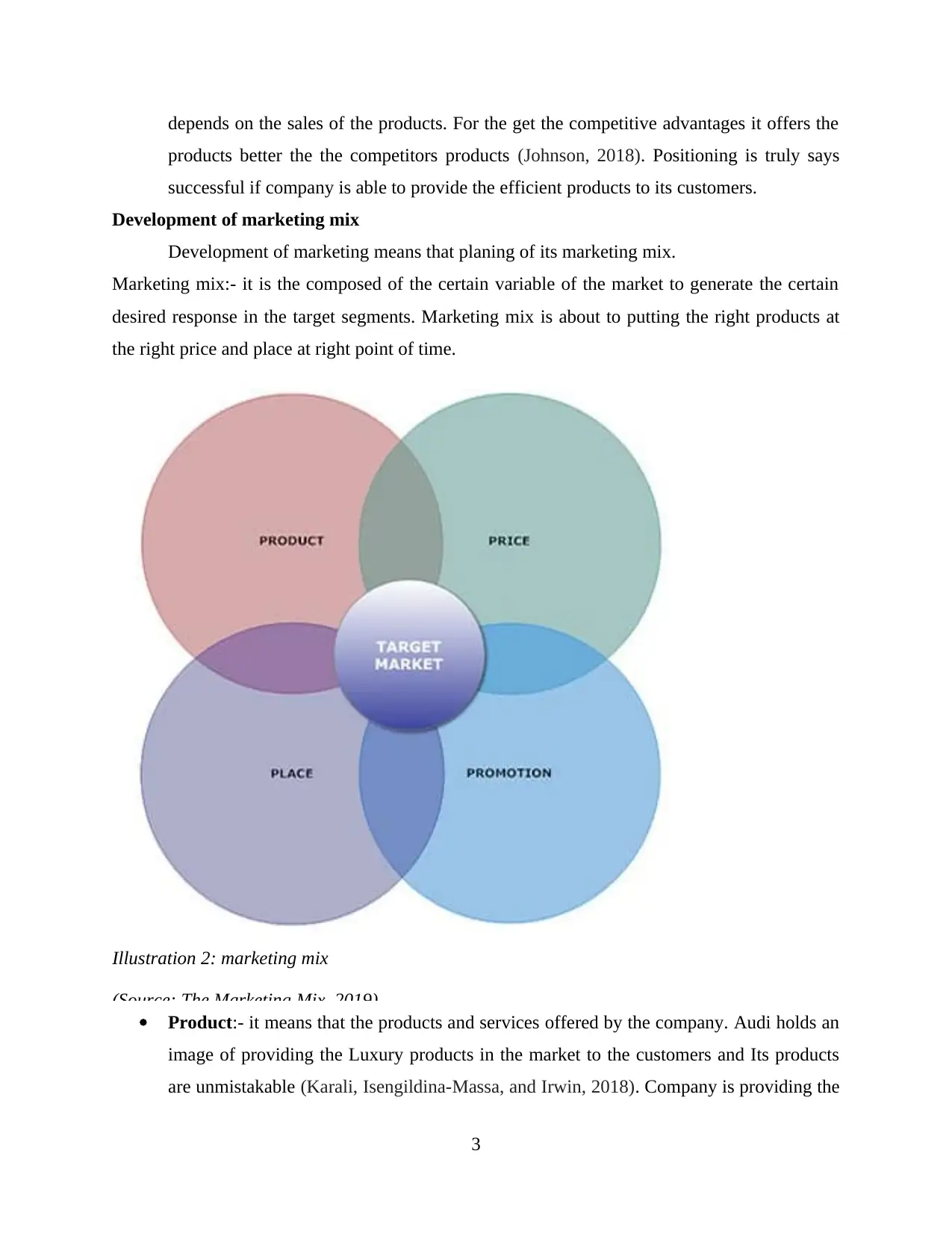
depends on the sales of the products. For the get the competitive advantages it offers the
products better the the competitors products (Johnson, 2018). Positioning is truly says
successful if company is able to provide the efficient products to its customers.
Development of marketing mix
Development of marketing means that planing of its marketing mix.
Marketing mix:- it is the composed of the certain variable of the market to generate the certain
desired response in the target segments. Marketing mix is about to putting the right products at
the right price and place at right point of time.
Illustration 2: marketing mix
(Source: The Marketing Mix, 2019)
Product:- it means that the products and services offered by the company. Audi holds an
image of providing the Luxury products in the market to the customers and Its products
are unmistakable (Karali, Isengildina-Massa, and Irwin, 2018). Company is providing the
3
products better the the competitors products (Johnson, 2018). Positioning is truly says
successful if company is able to provide the efficient products to its customers.
Development of marketing mix
Development of marketing means that planing of its marketing mix.
Marketing mix:- it is the composed of the certain variable of the market to generate the certain
desired response in the target segments. Marketing mix is about to putting the right products at
the right price and place at right point of time.
Illustration 2: marketing mix
(Source: The Marketing Mix, 2019)
Product:- it means that the products and services offered by the company. Audi holds an
image of providing the Luxury products in the market to the customers and Its products
are unmistakable (Karali, Isengildina-Massa, and Irwin, 2018). Company is providing the
3
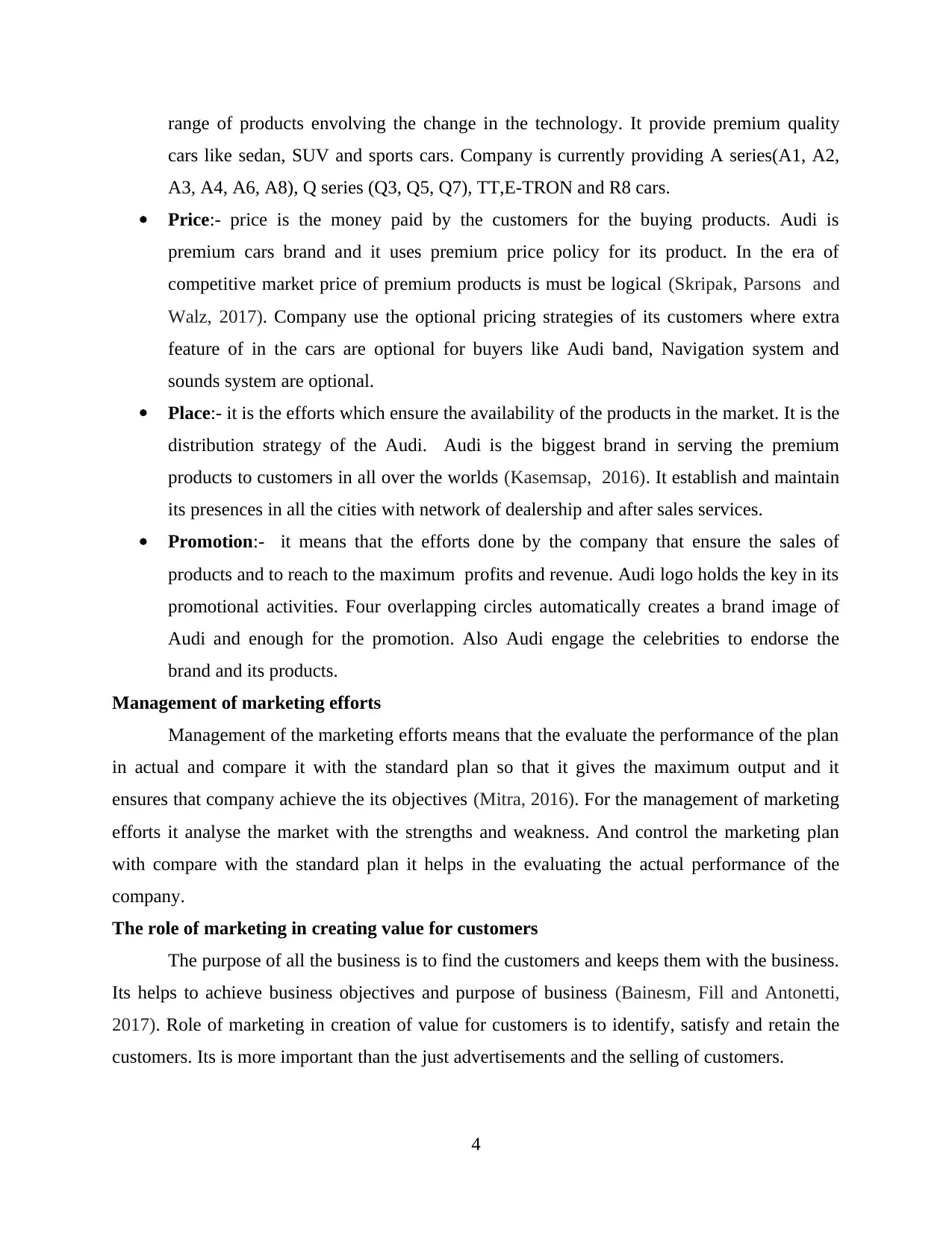
range of products envolving the change in the technology. It provide premium quality
cars like sedan, SUV and sports cars. Company is currently providing A series(A1, A2,
A3, A4, A6, A8), Q series (Q3, Q5, Q7), TT,E-TRON and R8 cars.
Price:- price is the money paid by the customers for the buying products. Audi is
premium cars brand and it uses premium price policy for its product. In the era of
competitive market price of premium products is must be logical (Skripak, Parsons and
Walz, 2017). Company use the optional pricing strategies of its customers where extra
feature of in the cars are optional for buyers like Audi band, Navigation system and
sounds system are optional.
Place:- it is the efforts which ensure the availability of the products in the market. It is the
distribution strategy of the Audi. Audi is the biggest brand in serving the premium
products to customers in all over the worlds (Kasemsap, 2016). It establish and maintain
its presences in all the cities with network of dealership and after sales services.
Promotion:- it means that the efforts done by the company that ensure the sales of
products and to reach to the maximum profits and revenue. Audi logo holds the key in its
promotional activities. Four overlapping circles automatically creates a brand image of
Audi and enough for the promotion. Also Audi engage the celebrities to endorse the
brand and its products.
Management of marketing efforts
Management of the marketing efforts means that the evaluate the performance of the plan
in actual and compare it with the standard plan so that it gives the maximum output and it
ensures that company achieve the its objectives (Mitra, 2016). For the management of marketing
efforts it analyse the market with the strengths and weakness. And control the marketing plan
with compare with the standard plan it helps in the evaluating the actual performance of the
company.
The role of marketing in creating value for customers
The purpose of all the business is to find the customers and keeps them with the business.
Its helps to achieve business objectives and purpose of business (Bainesm, Fill and Antonetti,
2017). Role of marketing in creation of value for customers is to identify, satisfy and retain the
customers. Its is more important than the just advertisements and the selling of customers.
4
cars like sedan, SUV and sports cars. Company is currently providing A series(A1, A2,
A3, A4, A6, A8), Q series (Q3, Q5, Q7), TT,E-TRON and R8 cars.
Price:- price is the money paid by the customers for the buying products. Audi is
premium cars brand and it uses premium price policy for its product. In the era of
competitive market price of premium products is must be logical (Skripak, Parsons and
Walz, 2017). Company use the optional pricing strategies of its customers where extra
feature of in the cars are optional for buyers like Audi band, Navigation system and
sounds system are optional.
Place:- it is the efforts which ensure the availability of the products in the market. It is the
distribution strategy of the Audi. Audi is the biggest brand in serving the premium
products to customers in all over the worlds (Kasemsap, 2016). It establish and maintain
its presences in all the cities with network of dealership and after sales services.
Promotion:- it means that the efforts done by the company that ensure the sales of
products and to reach to the maximum profits and revenue. Audi logo holds the key in its
promotional activities. Four overlapping circles automatically creates a brand image of
Audi and enough for the promotion. Also Audi engage the celebrities to endorse the
brand and its products.
Management of marketing efforts
Management of the marketing efforts means that the evaluate the performance of the plan
in actual and compare it with the standard plan so that it gives the maximum output and it
ensures that company achieve the its objectives (Mitra, 2016). For the management of marketing
efforts it analyse the market with the strengths and weakness. And control the marketing plan
with compare with the standard plan it helps in the evaluating the actual performance of the
company.
The role of marketing in creating value for customers
The purpose of all the business is to find the customers and keeps them with the business.
Its helps to achieve business objectives and purpose of business (Bainesm, Fill and Antonetti,
2017). Role of marketing in creation of value for customers is to identify, satisfy and retain the
customers. Its is more important than the just advertisements and the selling of customers.
4
⊘ This is a preview!⊘
Do you want full access?
Subscribe today to unlock all pages.

Trusted by 1+ million students worldwide
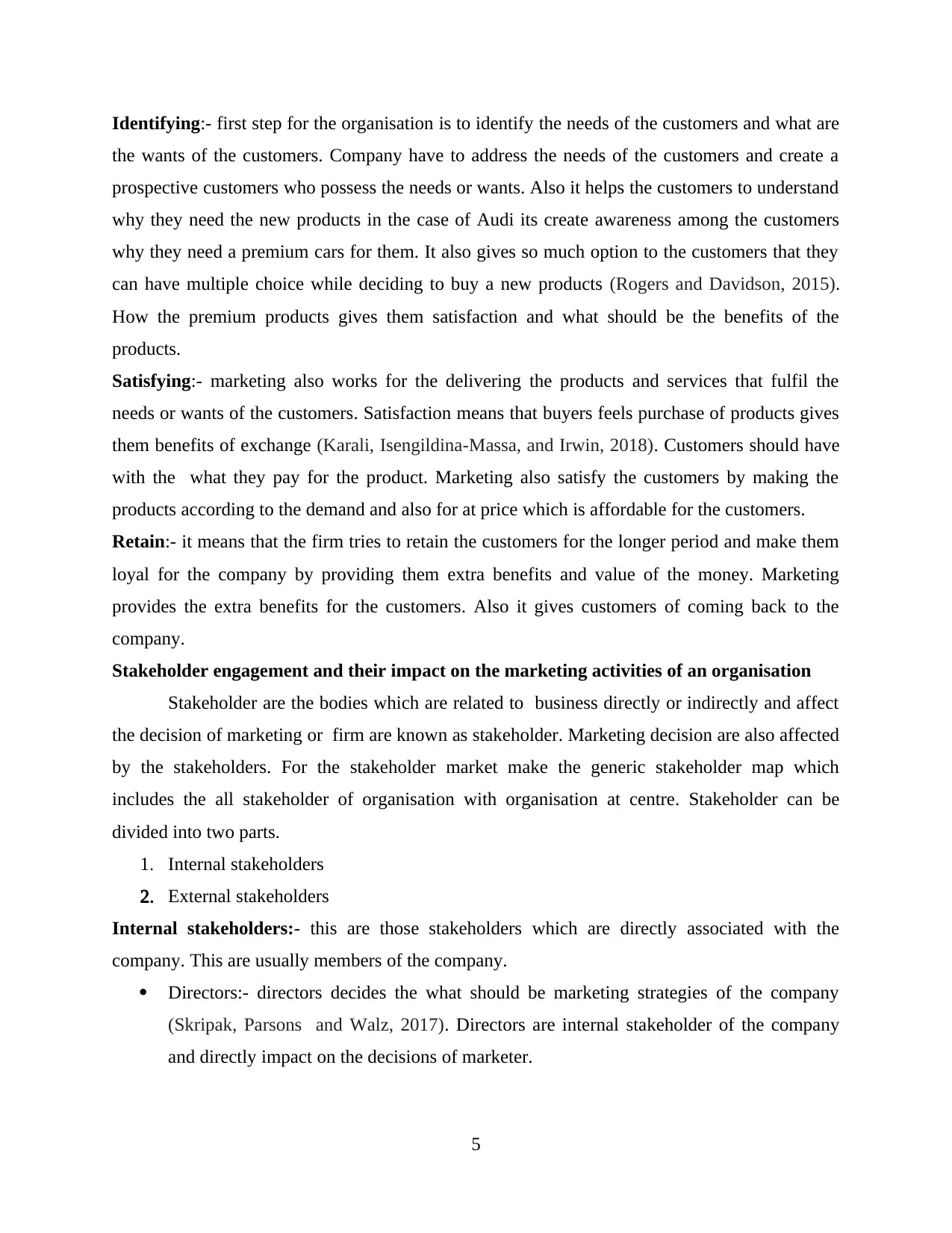
Identifying:- first step for the organisation is to identify the needs of the customers and what are
the wants of the customers. Company have to address the needs of the customers and create a
prospective customers who possess the needs or wants. Also it helps the customers to understand
why they need the new products in the case of Audi its create awareness among the customers
why they need a premium cars for them. It also gives so much option to the customers that they
can have multiple choice while deciding to buy a new products (Rogers and Davidson, 2015).
How the premium products gives them satisfaction and what should be the benefits of the
products.
Satisfying:- marketing also works for the delivering the products and services that fulfil the
needs or wants of the customers. Satisfaction means that buyers feels purchase of products gives
them benefits of exchange (Karali, Isengildina-Massa, and Irwin, 2018). Customers should have
with the what they pay for the product. Marketing also satisfy the customers by making the
products according to the demand and also for at price which is affordable for the customers.
Retain:- it means that the firm tries to retain the customers for the longer period and make them
loyal for the company by providing them extra benefits and value of the money. Marketing
provides the extra benefits for the customers. Also it gives customers of coming back to the
company.
Stakeholder engagement and their impact on the marketing activities of an organisation
Stakeholder are the bodies which are related to business directly or indirectly and affect
the decision of marketing or firm are known as stakeholder. Marketing decision are also affected
by the stakeholders. For the stakeholder market make the generic stakeholder map which
includes the all stakeholder of organisation with organisation at centre. Stakeholder can be
divided into two parts.
1. Internal stakeholders
2. External stakeholders
Internal stakeholders:- this are those stakeholders which are directly associated with the
company. This are usually members of the company.
Directors:- directors decides the what should be marketing strategies of the company
(Skripak, Parsons and Walz, 2017). Directors are internal stakeholder of the company
and directly impact on the decisions of marketer.
5
the wants of the customers. Company have to address the needs of the customers and create a
prospective customers who possess the needs or wants. Also it helps the customers to understand
why they need the new products in the case of Audi its create awareness among the customers
why they need a premium cars for them. It also gives so much option to the customers that they
can have multiple choice while deciding to buy a new products (Rogers and Davidson, 2015).
How the premium products gives them satisfaction and what should be the benefits of the
products.
Satisfying:- marketing also works for the delivering the products and services that fulfil the
needs or wants of the customers. Satisfaction means that buyers feels purchase of products gives
them benefits of exchange (Karali, Isengildina-Massa, and Irwin, 2018). Customers should have
with the what they pay for the product. Marketing also satisfy the customers by making the
products according to the demand and also for at price which is affordable for the customers.
Retain:- it means that the firm tries to retain the customers for the longer period and make them
loyal for the company by providing them extra benefits and value of the money. Marketing
provides the extra benefits for the customers. Also it gives customers of coming back to the
company.
Stakeholder engagement and their impact on the marketing activities of an organisation
Stakeholder are the bodies which are related to business directly or indirectly and affect
the decision of marketing or firm are known as stakeholder. Marketing decision are also affected
by the stakeholders. For the stakeholder market make the generic stakeholder map which
includes the all stakeholder of organisation with organisation at centre. Stakeholder can be
divided into two parts.
1. Internal stakeholders
2. External stakeholders
Internal stakeholders:- this are those stakeholders which are directly associated with the
company. This are usually members of the company.
Directors:- directors decides the what should be marketing strategies of the company
(Skripak, Parsons and Walz, 2017). Directors are internal stakeholder of the company
and directly impact on the decisions of marketer.
5
Paraphrase This Document
Need a fresh take? Get an instant paraphrase of this document with our AI Paraphraser
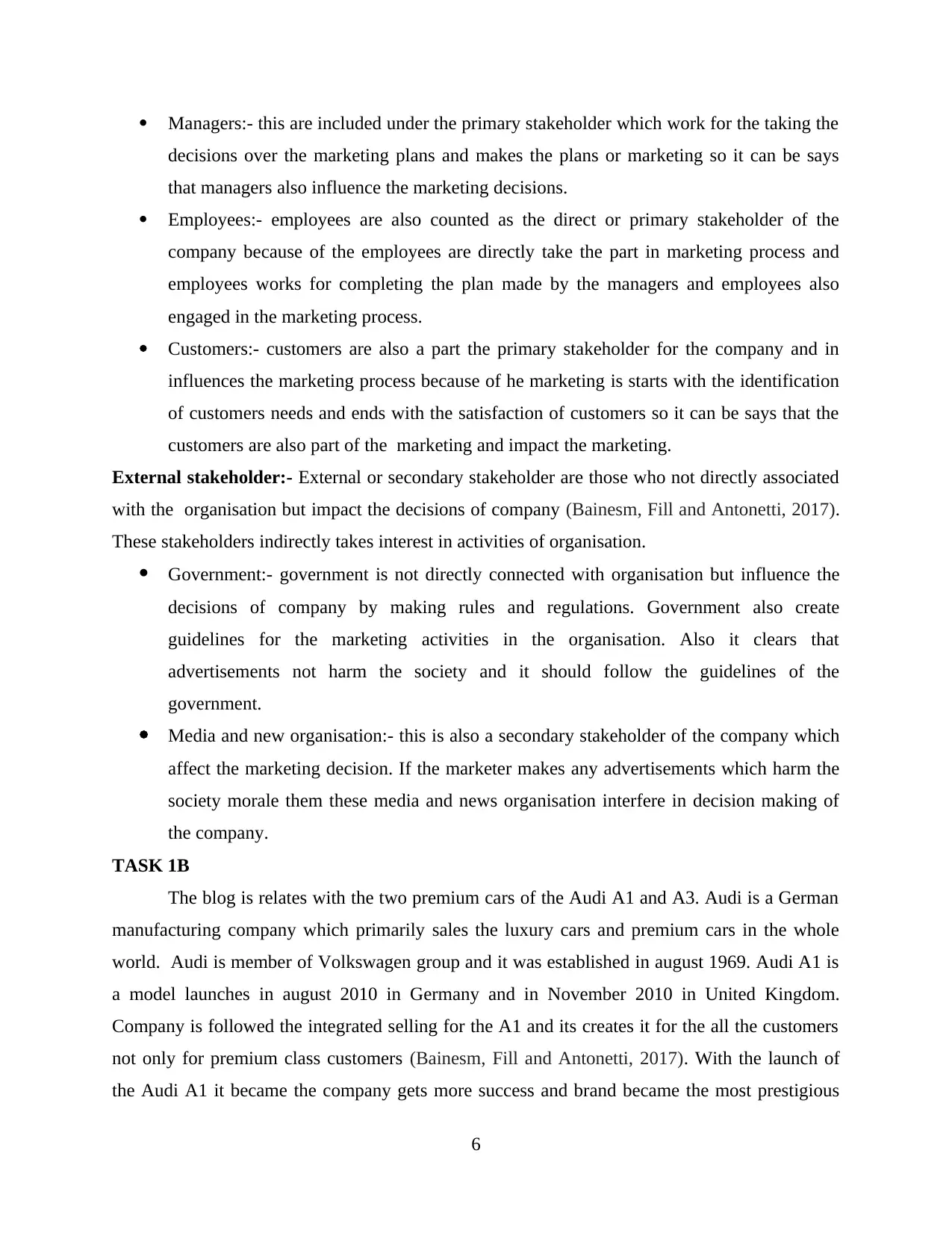
Managers:- this are included under the primary stakeholder which work for the taking the
decisions over the marketing plans and makes the plans or marketing so it can be says
that managers also influence the marketing decisions.
Employees:- employees are also counted as the direct or primary stakeholder of the
company because of the employees are directly take the part in marketing process and
employees works for completing the plan made by the managers and employees also
engaged in the marketing process.
Customers:- customers are also a part the primary stakeholder for the company and in
influences the marketing process because of he marketing is starts with the identification
of customers needs and ends with the satisfaction of customers so it can be says that the
customers are also part of the marketing and impact the marketing.
External stakeholder:- External or secondary stakeholder are those who not directly associated
with the organisation but impact the decisions of company (Bainesm, Fill and Antonetti, 2017).
These stakeholders indirectly takes interest in activities of organisation.
Government:- government is not directly connected with organisation but influence the
decisions of company by making rules and regulations. Government also create
guidelines for the marketing activities in the organisation. Also it clears that
advertisements not harm the society and it should follow the guidelines of the
government.
Media and new organisation:- this is also a secondary stakeholder of the company which
affect the marketing decision. If the marketer makes any advertisements which harm the
society morale them these media and news organisation interfere in decision making of
the company.
TASK 1B
The blog is relates with the two premium cars of the Audi A1 and A3. Audi is a German
manufacturing company which primarily sales the luxury cars and premium cars in the whole
world. Audi is member of Volkswagen group and it was established in august 1969. Audi A1 is
a model launches in august 2010 in Germany and in November 2010 in United Kingdom.
Company is followed the integrated selling for the A1 and its creates it for the all the customers
not only for premium class customers (Bainesm, Fill and Antonetti, 2017). With the launch of
the Audi A1 it became the company gets more success and brand became the most prestigious
6
decisions over the marketing plans and makes the plans or marketing so it can be says
that managers also influence the marketing decisions.
Employees:- employees are also counted as the direct or primary stakeholder of the
company because of the employees are directly take the part in marketing process and
employees works for completing the plan made by the managers and employees also
engaged in the marketing process.
Customers:- customers are also a part the primary stakeholder for the company and in
influences the marketing process because of he marketing is starts with the identification
of customers needs and ends with the satisfaction of customers so it can be says that the
customers are also part of the marketing and impact the marketing.
External stakeholder:- External or secondary stakeholder are those who not directly associated
with the organisation but impact the decisions of company (Bainesm, Fill and Antonetti, 2017).
These stakeholders indirectly takes interest in activities of organisation.
Government:- government is not directly connected with organisation but influence the
decisions of company by making rules and regulations. Government also create
guidelines for the marketing activities in the organisation. Also it clears that
advertisements not harm the society and it should follow the guidelines of the
government.
Media and new organisation:- this is also a secondary stakeholder of the company which
affect the marketing decision. If the marketer makes any advertisements which harm the
society morale them these media and news organisation interfere in decision making of
the company.
TASK 1B
The blog is relates with the two premium cars of the Audi A1 and A3. Audi is a German
manufacturing company which primarily sales the luxury cars and premium cars in the whole
world. Audi is member of Volkswagen group and it was established in august 1969. Audi A1 is
a model launches in august 2010 in Germany and in November 2010 in United Kingdom.
Company is followed the integrated selling for the A1 and its creates it for the all the customers
not only for premium class customers (Bainesm, Fill and Antonetti, 2017). With the launch of
the Audi A1 it became the company gets more success and brand became the most prestigious
6
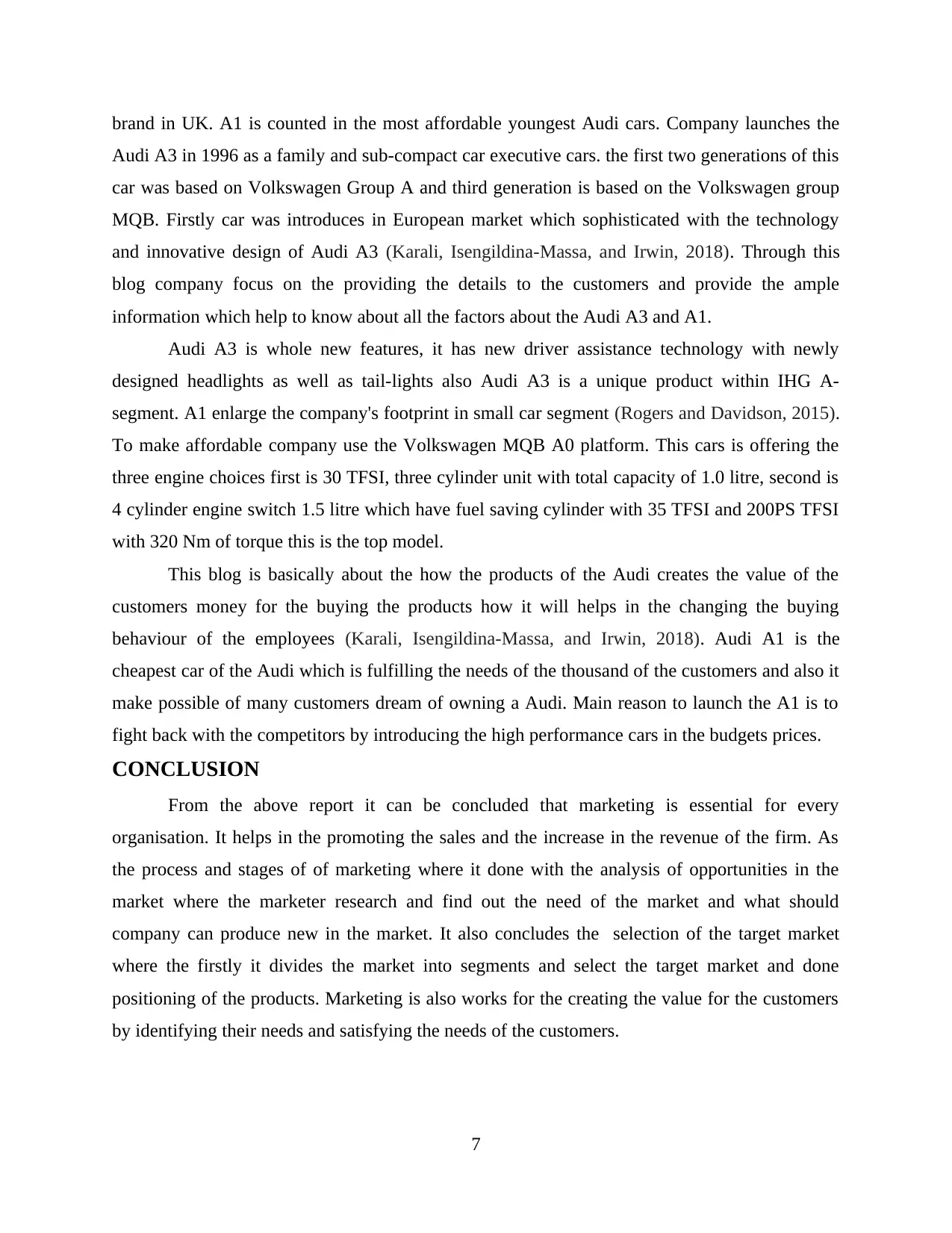
brand in UK. A1 is counted in the most affordable youngest Audi cars. Company launches the
Audi A3 in 1996 as a family and sub-compact car executive cars. the first two generations of this
car was based on Volkswagen Group A and third generation is based on the Volkswagen group
MQB. Firstly car was introduces in European market which sophisticated with the technology
and innovative design of Audi A3 (Karali, Isengildina-Massa, and Irwin, 2018). Through this
blog company focus on the providing the details to the customers and provide the ample
information which help to know about all the factors about the Audi A3 and A1.
Audi A3 is whole new features, it has new driver assistance technology with newly
designed headlights as well as tail-lights also Audi A3 is a unique product within IHG A-
segment. A1 enlarge the company's footprint in small car segment (Rogers and Davidson, 2015).
To make affordable company use the Volkswagen MQB A0 platform. This cars is offering the
three engine choices first is 30 TFSI, three cylinder unit with total capacity of 1.0 litre, second is
4 cylinder engine switch 1.5 litre which have fuel saving cylinder with 35 TFSI and 200PS TFSI
with 320 Nm of torque this is the top model.
This blog is basically about the how the products of the Audi creates the value of the
customers money for the buying the products how it will helps in the changing the buying
behaviour of the employees (Karali, Isengildina-Massa, and Irwin, 2018). Audi A1 is the
cheapest car of the Audi which is fulfilling the needs of the thousand of the customers and also it
make possible of many customers dream of owning a Audi. Main reason to launch the A1 is to
fight back with the competitors by introducing the high performance cars in the budgets prices.
CONCLUSION
From the above report it can be concluded that marketing is essential for every
organisation. It helps in the promoting the sales and the increase in the revenue of the firm. As
the process and stages of of marketing where it done with the analysis of opportunities in the
market where the marketer research and find out the need of the market and what should
company can produce new in the market. It also concludes the selection of the target market
where the firstly it divides the market into segments and select the target market and done
positioning of the products. Marketing is also works for the creating the value for the customers
by identifying their needs and satisfying the needs of the customers.
7
Audi A3 in 1996 as a family and sub-compact car executive cars. the first two generations of this
car was based on Volkswagen Group A and third generation is based on the Volkswagen group
MQB. Firstly car was introduces in European market which sophisticated with the technology
and innovative design of Audi A3 (Karali, Isengildina-Massa, and Irwin, 2018). Through this
blog company focus on the providing the details to the customers and provide the ample
information which help to know about all the factors about the Audi A3 and A1.
Audi A3 is whole new features, it has new driver assistance technology with newly
designed headlights as well as tail-lights also Audi A3 is a unique product within IHG A-
segment. A1 enlarge the company's footprint in small car segment (Rogers and Davidson, 2015).
To make affordable company use the Volkswagen MQB A0 platform. This cars is offering the
three engine choices first is 30 TFSI, three cylinder unit with total capacity of 1.0 litre, second is
4 cylinder engine switch 1.5 litre which have fuel saving cylinder with 35 TFSI and 200PS TFSI
with 320 Nm of torque this is the top model.
This blog is basically about the how the products of the Audi creates the value of the
customers money for the buying the products how it will helps in the changing the buying
behaviour of the employees (Karali, Isengildina-Massa, and Irwin, 2018). Audi A1 is the
cheapest car of the Audi which is fulfilling the needs of the thousand of the customers and also it
make possible of many customers dream of owning a Audi. Main reason to launch the A1 is to
fight back with the competitors by introducing the high performance cars in the budgets prices.
CONCLUSION
From the above report it can be concluded that marketing is essential for every
organisation. It helps in the promoting the sales and the increase in the revenue of the firm. As
the process and stages of of marketing where it done with the analysis of opportunities in the
market where the marketer research and find out the need of the market and what should
company can produce new in the market. It also concludes the selection of the target market
where the firstly it divides the market into segments and select the target market and done
positioning of the products. Marketing is also works for the creating the value for the customers
by identifying their needs and satisfying the needs of the customers.
7
⊘ This is a preview!⊘
Do you want full access?
Subscribe today to unlock all pages.

Trusted by 1+ million students worldwide
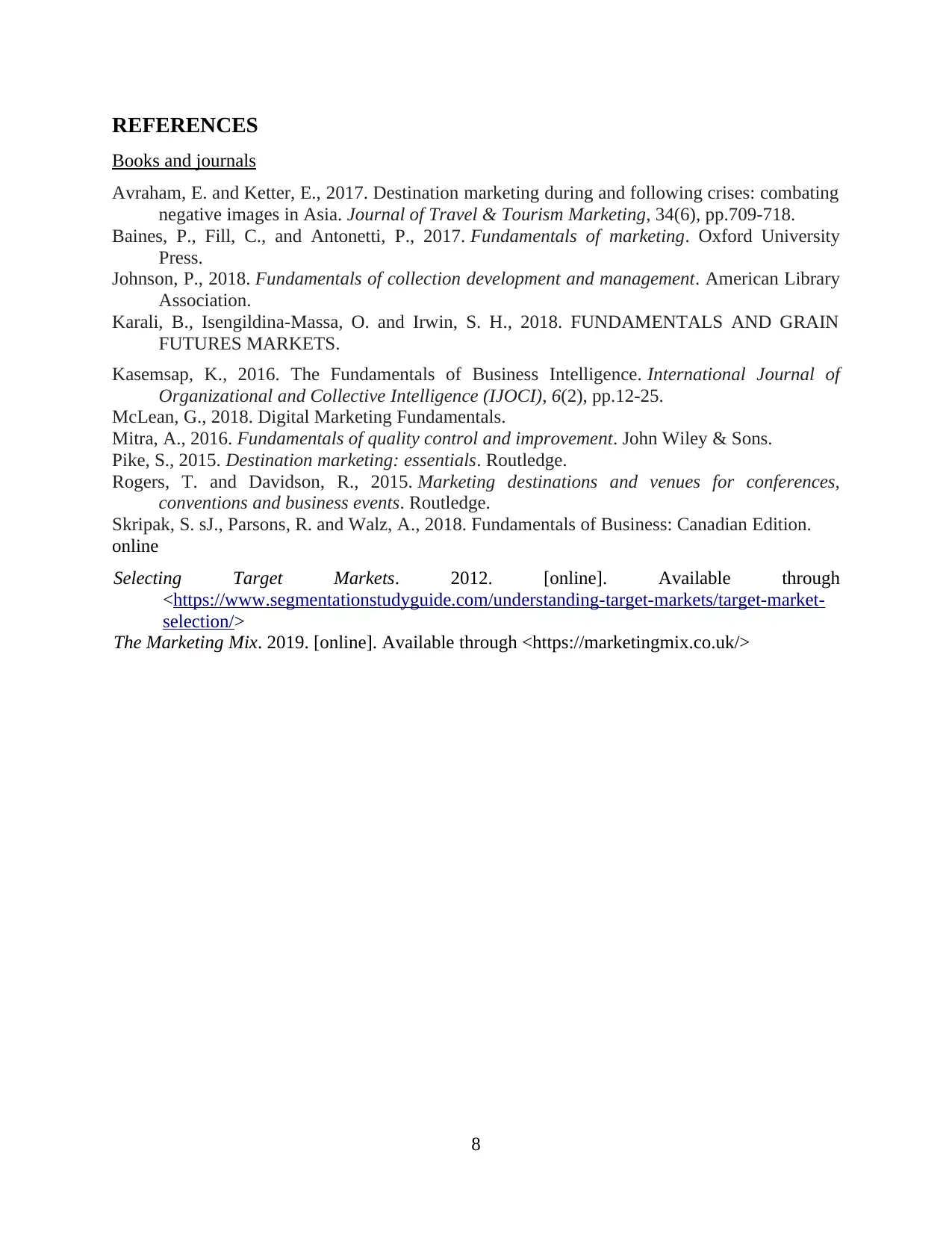
REFERENCES
Books and journals
Avraham, E. and Ketter, E., 2017. Destination marketing during and following crises: combating
negative images in Asia. Journal of Travel & Tourism Marketing, 34(6), pp.709-718.
Baines, P., Fill, C., and Antonetti, P., 2017. Fundamentals of marketing. Oxford University
Press.
Johnson, P., 2018. Fundamentals of collection development and management. American Library
Association.
Karali, B., Isengildina-Massa, O. and Irwin, S. H., 2018. FUNDAMENTALS AND GRAIN
FUTURES MARKETS.
Kasemsap, K., 2016. The Fundamentals of Business Intelligence. International Journal of
Organizational and Collective Intelligence (IJOCI), 6(2), pp.12-25.
McLean, G., 2018. Digital Marketing Fundamentals.
Mitra, A., 2016. Fundamentals of quality control and improvement. John Wiley & Sons.
Pike, S., 2015. Destination marketing: essentials. Routledge.
Rogers, T. and Davidson, R., 2015. Marketing destinations and venues for conferences,
conventions and business events. Routledge.
Skripak, S. sJ., Parsons, R. and Walz, A., 2018. Fundamentals of Business: Canadian Edition.
online
Selecting Target Markets. 2012. [online]. Available through
<https://www.segmentationstudyguide.com/understanding-target-markets/target-market-
selection/>
The Marketing Mix. 2019. [online]. Available through <https://marketingmix.co.uk/>
8
Books and journals
Avraham, E. and Ketter, E., 2017. Destination marketing during and following crises: combating
negative images in Asia. Journal of Travel & Tourism Marketing, 34(6), pp.709-718.
Baines, P., Fill, C., and Antonetti, P., 2017. Fundamentals of marketing. Oxford University
Press.
Johnson, P., 2018. Fundamentals of collection development and management. American Library
Association.
Karali, B., Isengildina-Massa, O. and Irwin, S. H., 2018. FUNDAMENTALS AND GRAIN
FUTURES MARKETS.
Kasemsap, K., 2016. The Fundamentals of Business Intelligence. International Journal of
Organizational and Collective Intelligence (IJOCI), 6(2), pp.12-25.
McLean, G., 2018. Digital Marketing Fundamentals.
Mitra, A., 2016. Fundamentals of quality control and improvement. John Wiley & Sons.
Pike, S., 2015. Destination marketing: essentials. Routledge.
Rogers, T. and Davidson, R., 2015. Marketing destinations and venues for conferences,
conventions and business events. Routledge.
Skripak, S. sJ., Parsons, R. and Walz, A., 2018. Fundamentals of Business: Canadian Edition.
online
Selecting Target Markets. 2012. [online]. Available through
<https://www.segmentationstudyguide.com/understanding-target-markets/target-market-
selection/>
The Marketing Mix. 2019. [online]. Available through <https://marketingmix.co.uk/>
8
1 out of 10
Related Documents
Your All-in-One AI-Powered Toolkit for Academic Success.
+13062052269
info@desklib.com
Available 24*7 on WhatsApp / Email
![[object Object]](/_next/static/media/star-bottom.7253800d.svg)
Unlock your academic potential
Copyright © 2020–2025 A2Z Services. All Rights Reserved. Developed and managed by ZUCOL.





